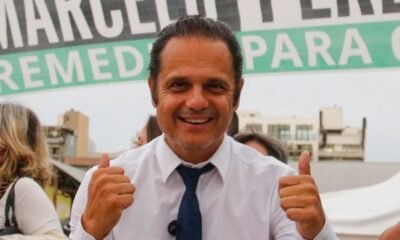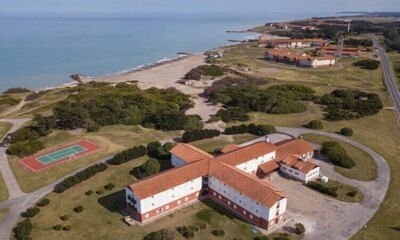INTERNACIONAL
La sequía en San Pablo y el riesgo de inundaciones en la Amazonia reflejan las paradojas climáticas del país y políticas ambientales obsoletas
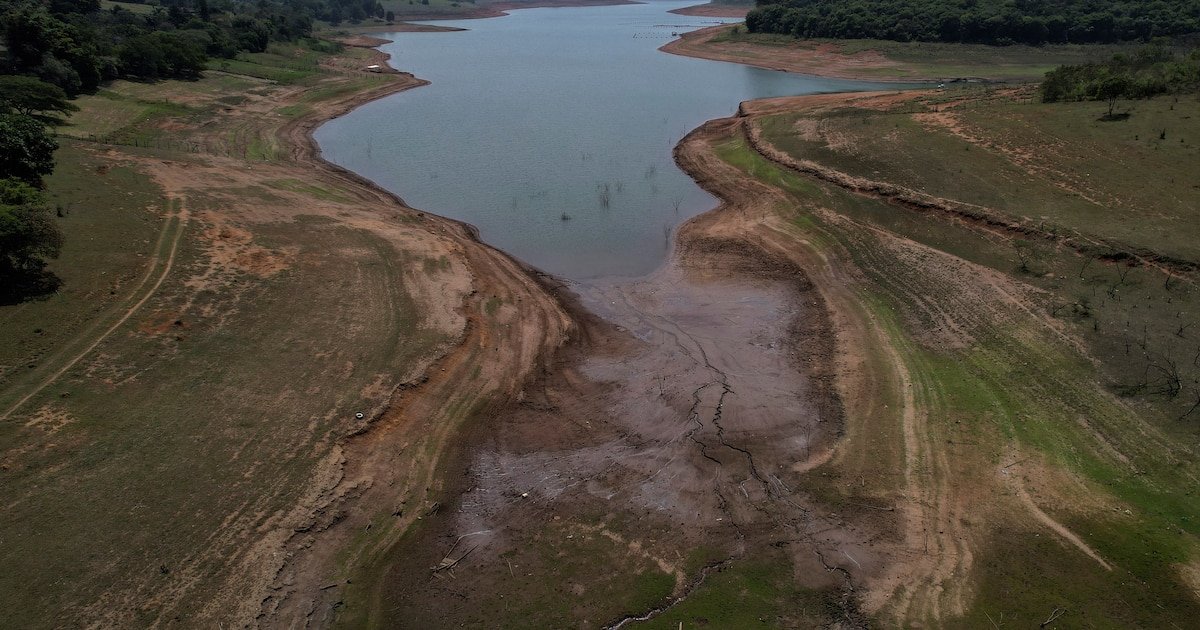
El Sistema Cantareira, principal complejo de reservas hídricas que abastece a la región metropolitana de San Pablo, registró en septiembre el nivel de agua más bajo de los últimos diez años, cuando el estado de San Pablo sufrió una de las sequías más trágicas de su historia. Las consecuencias en aquel momento fueron graves: racionamiento de agua y daños significativos a la agricultura y la ganadería. Pero, sobre todo, la crisis se extendió a toda la región sudeste de Brasil, afectando también a los estados de Minas Gerais y Espírito Santo. Según un estudio publicado en la revista científica Science, fue la novena sequía más grave del mundo entre 1980 y 2018.
Este fenómeno extremo se debió principalmente a un cambio anómalo en la posición de un gran sistema de alta presión en el Atlántico Sur (denominado ASAS). Este sistema se desplazó más cerca del continente, funcionando como una especie de “barrera” que bloqueaba la llegada de nubes cargadas de humedad al sureste de Brasil. Como consecuencia, las lluvias que normalmente caen en abundancia en esa época no llegaron o fueron muy irregulares. Además, el fenómeno climático El Niño, que altera aún más el régimen de lluvias, contribuyó a empeorar la situación.
La sequía de hace 10 años fue solo una de las varias señales de alarma que también explican la situación actual. De hecho, desde los años 90, los periodos de interrupción de la temporada de lluvias, los llamados veranillos, son cada vez más largos. La semana pasada, según los datos difundidos por Sabesp, la empresa pública de servicios básicos de saneamiento del estado de San Pablo, el volumen operativo del Sistema Cantareira alcanzó apenas el 29,5%, mientras que en el mismo período de 2024 el nivel era del 53%.
El Sistema Cantareira está formado por cinco grandes embalses artificiales conectados entre sí, los de Jaguari, Jacareí, Cachoeira, Atibainha y Paulo de Paiva Castro, que juntos acumulan y regulan el suministro de agua de gran parte del estado de San Pablo. Ante esta situación crítica, Sabesp declaró el estado de “escasez” de agua y anunció nuevas medidas para contener el consumo.
A partir del 22 de septiembre, la empresa amplió de 8 a 10 horas la reducción de la presión del agua en los hogares. La situación se supervisa constantemente y, en caso de que empeore aún más, ya se ha anunciado que podrían adoptarse medidas adicionales. En comparación con hace diez años, Sabesp ha ampliado las interconexiones entre los sistemas, lo que permite la redistribución de los trasvases de agua para reequilibrar los niveles hídricos, y ha trabajado para restaurar manantiales, embalses y fuentes.

Sin embargo, algunas cuestiones críticas siguen planteando problemas. En primer lugar, el 29,5% del agua tratada se desperdicia debido a filtraciones o conexiones ilegales. A esto se suma el comportamiento de los consumidores, que solo muy lentamente están empezando a utilizar el agua de forma más consciente, con una reducción per cápita desde 2015 de apenas el 15%.
Como subraya un editorial del diario Folha de São Paulo, “la combinación del crecimiento demográfico y las condiciones climáticas inestables exige ahora una planificación urbana a largo plazo, soluciones integradas de conservación y grandes inversiones en infraestructuras: otras áreas metropolitanas de todo el mundo ya están experimentando la escasez de agua como algo cotidiano”.
El caso de San Pablo no es más que la punta del iceberg. Un nuevo informe de la Organización Meteorológica Mundial (OMM) de las Naciones Unidas, publicado estos días, ha dado la voz de alarma sobre un ciclo hidrológico global cada vez más desequilibrado, caracterizado por sequías prolongadas e inundaciones devastadoras.
El documento, titulado “Estado de los recursos hídricos mundiales 2024”, muestra que solo un tercio de las cuencas hidrográficas del mundo ha registrado condiciones normales, mientras que las demás han sufrido exceso o escasez de agua. 2024 fue el año más caluroso jamás registrado, con un papel determinante del fenómeno de El Niño.
El informe dedica un amplio espacio a Brasil, subrayando cómo los extremos climáticos se han manifestado con fuerza en los últimos años. Por un lado, la severa sequía que desde 2023 ha afectado a la Amazonia hasta alcanzar el 59% de su territorio en 2024, con graves repercusiones medioambientales y sociales. Por otro lado, las devastadoras inundaciones que el año pasado afectaron al sur del país, en particular al estado de Rio Grande do Sul, y que causaron casi 200 muertos y miles de desplazados, en lo que ha sido una de las peores catástrofes climáticas nacionales.

Paradójicamente, este año la Amazonia corre el riesgo de vivir una situación opuesta. El pasado mes de julio, el río Negro, cerca de la ciudad de Manaos, en el estado de Amazonas, registró una bajada de las aguas de 53 centímetros, con una media de 1,71 cm al día, según los datos del puerto de Manaos, que supervisa diariamente el nivel del río.
El 1 de agosto, el nivel era de 28,49 metros. Además, en los últimos meses, el río alcanzó un máximo de 29,05 metros, solo cinco centímetros por encima del umbral de inundación grave, que se sitúa a partir de los 29 metros. El proceso de crecida comenzó en octubre de 2024, tras la peor sequía de los últimos cien años en el estado de Amazonas. Otro ejemplo de cómo los fenómenos climáticos se manifiestan de forma cada vez más extrema lo demuestra también el estado de San Pablo.
El lunes, una violenta tormenta de lluvia, aunque no fue suficiente para elevar el nivel de las reservas de agua, sí causó destrucción. Emblemático es el caso de la fábrica de Toyota en Porto Feliz, en el estado de San Pablo. Todo el techo de la fábrica fue arrancado por las violentas ráfagas de viento. Según informó la misma multinacional japonesa, los daños paralizarán la producción al menos hasta enero del próximo año.
Un estudio publicado en septiembre en Nature Communications señala a la deforestación, especialmente en la Amazonia, como responsable, según la investigación realizada por científicos brasileños e internacionales, del 75% de la reducción de las lluvias en la estación seca en la Amazonia desde 1985.
La destrucción de la selva conlleva una pérdida de al menos 15,8 mm de lluvia por estación seca y un aumento medio de la temperatura de unos 2 °C. Sin embargo, los investigadores también han alertado de que los efectos de la deforestación se extienden más allá de la selva.
La Amazonia alimenta a todo Brasil con humedad a través de los llamados “ríos voladores”, corrientes de vapor de agua que abastecen de lluvia a las regiones agrícolas del centro-oeste y el sureste del país. La disminución de este flujo reduce la productividad agrícola, afecta a la pesca y a las comunidades que dependen de los cursos de agua, y contribuye a que se produzcan períodos de sequía más frecuentes e intensos, además de incendios y olas de calor.

Si el ritmo actual de deforestación continúa, se prevé que para 2035 las temperaturas máximas aumenten 2,64 °C y las precipitaciones disminuyan 28,3 mm por estación seca en comparación con 1985.
Por su parte, un editorial publicado el pasado mes de marzo en Science atacó las políticas medioambientales del Gobierno brasileño, que pondrían en peligro el equilibrio climático e hídrico de Brasil. Según los investigadores Philip Fearnside y Walter Leal Filho, gran parte de los sectores gubernamentales promueven actividades que aumentan las emisiones de gases de efecto invernadero. Entre los ejemplos citados se encuentran las subvenciones para transformar pastos en cultivos de soja y la asfaltada de la carretera BR-319 que atraviesa la Amazonia, iniciativas que fomentan la deforestación.
Por no hablar de la apertura de pozos petrolíferos en la Amazonia, un proyecto que parece estar cada vez más cerca de realizarse, ya que esta misma semana el Instituto Brasileño del Medio Ambiente y los Recursos Naturales Renovables (IBAMA) ha aprobado una prueba realizada en agosto por Petrobras, en el marco de un amplio ejercicio de emergencia solicitado por el organismo medioambiental para obtener una licencia de perforación en la cuenca del río Amazonas.
Incluso el sistema de previsión adoptado por el Operador Nacional del Sistema Eléctrico (ONS) en Brasil ya es considerado obsoleto por los expertos, ya que se basa en datos históricos de 90 años y no tiene en cuenta los efectos del cambio climático. El modelo no logra detectar nuevos patrones de escasez o abundancia de agua, lo que dificulta la gestión de las cuencas hidrográficas y aumenta la fragilidad del sistema energético. Esto conlleva un mayor riesgo de cortes de electricidad y contribuye al aumento de los costes energéticos, con consecuencias para toda la economía y los hogares.
La secretaria general de la Organización Meteorológica Mundial (OMM), Celeste Saulo, ha dado recientemente la voz de alarma. “El agua sustenta nuestras sociedades, alimenta la economía y es fundamental para los ecosistemas. Pero cada vez está más bajo presión. Sin datos precisos, avanzamos a ciegas”, afirmó.
2021,embalse,presa jaguari brasil
INTERNACIONAL
Former French President Sarkozy begins a 5-year prison sentence for campaign finance conspiracy
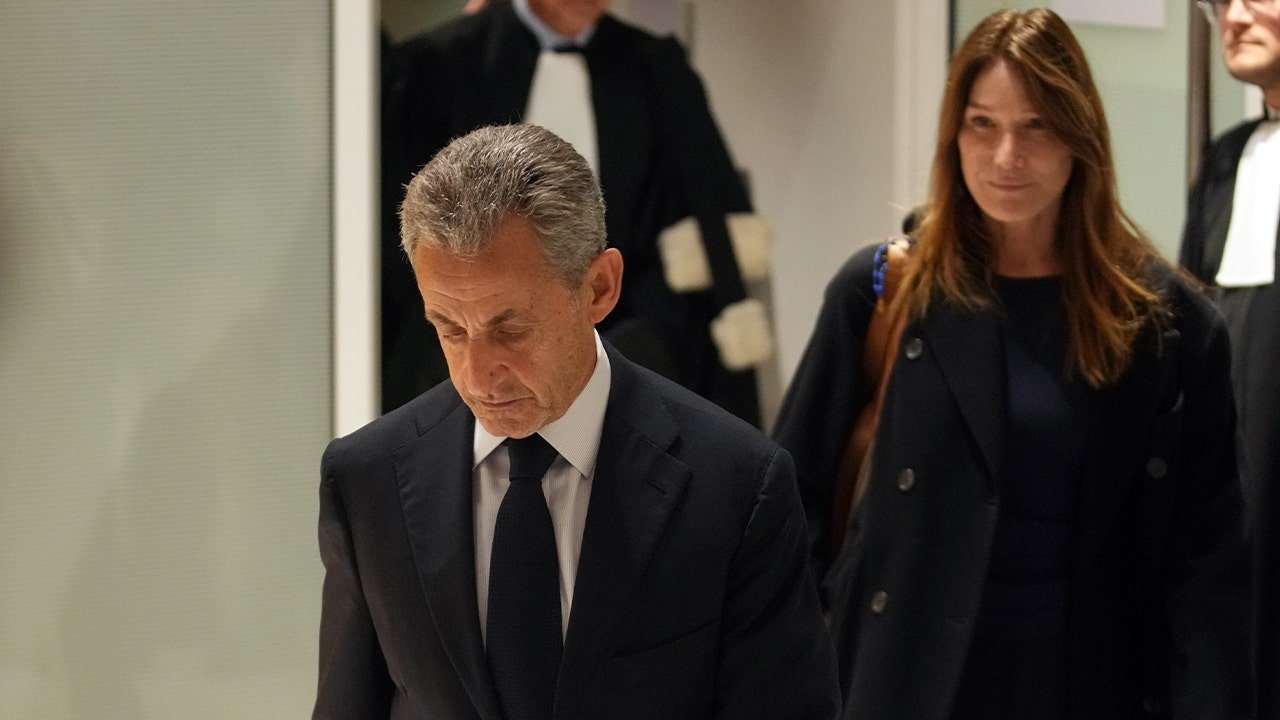
NEWYou can now listen to Fox News articles!
Former French President Nicolas Sarkozy entered a prison in Paris on Tuesday to begin serving a 5-year sentence for a criminal conspiracy to finance his 2007 election campaign with funds from Libya — a historic moment that makes him the first ex-leader of modern France to be imprisoned.
Sarkozy, 70, was greeted by hundreds of supporters when he walked out of his Paris home earlier in the day hand-in-hand with his wife, supermodel-turned-singer Carla Bruni-Sarkozy. He embraced her before getting into a police car.
Minutes later, the vehicle passed through the gates of the notorious La Santé prison — where Sarkozy will now serve his sentence in solitary confinement.
Sarkozy was convicted last month of criminal conspiracy in a scheme to finance his 2007 election campaign with funds from Libya.
He contests both the conviction and a judge’s unusual decision to incarcerate him pending appeal. His lawyers said Tuesday that they filed an immediate request for his release.
FORMER FRENCH PRESIDENT NICOLAS SARKOZY SENTENCED TO FIVE YEARS IN LIBYA CORRUPTION CASE
Former French President Nicolas Sarkozy and his wife Carla Bruni-Sarkozy leave their home on Tuesday, Oct. 21, 2025, in Paris as Nicolas Sarkozy heads to prison to serve time for a criminal conspiracy to finance his 2007 election campaign with funds from Libya. (AP Photo/Thibault Camus)
A show of defiance
«It’s an ominous day for him, for France and for our institutions, because this incarceration is a disgrace,» Sarkozy’s lawyer Jean-Michel Darrois told reporters soon after his incarceration.
In a show of defiance and while on his way to the prison, Sarkozy released a statement on social media declaring that «an innocent man» was being locked up.
«I will continue to denounce this judicial scandal,» he wrote. «The truth will prevail.»
Sarkozy told Le Figaro newspaper that he would bring three books to prison — the maximum allowed — including Alexandre Dumas’ «The Count of Monte Cristo,″ in which the hero escapes from an island prison before seeking revenge. He also picked a biography of Jesus Christ.
«I’m not afraid of prison. I’ll hold my head high, including in front of the doors of La Santé,» he told La Tribune Dimanche newspaper last week. «I’ll fight till the end.»
Sarkozy has repeatedly said he is the victim of «a plot» staged by some people linked to the Libyan government and denounced the Sept. 25 verdict as a «scandal.»
TRUMP COMMUTES GEORGE SANTOS’ SENTENCE, PARDON BLITZ WIPES OUT COSTLY FEDERAL INVESTIGATIONS

Former French President Nicolas Sarkozy, center, arrives at La Sante prison to serve time for a criminal conspiracy to finance his 2007 election campaign with funds from Libya, on Tuesday, Oct. 21, 2025, in Paris. (AP Photo/Emma Da Silva)
Solitary confinement
Sarkozy’s lawyers said he will be kept away from all other prisoners for security reasons. They said he packed a bag with a few sweaters because the prison is cold and earplugs because it’s noisy.
Christophe Ingrain, another of Sarkozy’s lawyers, denounced «a serious injustice.»
«It’s a very difficult time, but the president has stood strong,» Ingrain said. «He doesn’t complain, hasn’t asked for anything, no special treatment.»
Solitary confinement implies that Sarkozy will never see other inmates and will spend most of his time alone in his cell, Ingrain said.
He will be allowed to go outdoors one hour per day alone in the prison yard and to get three visits per week from his family, Ingrain said, adding that he is planning to write a book about his prison experience.
BRAZIL’S EX-PRESIDENT AND MAJOR TRUMP ALLY BOLSONARO PLACED ON HOUSE ARREST
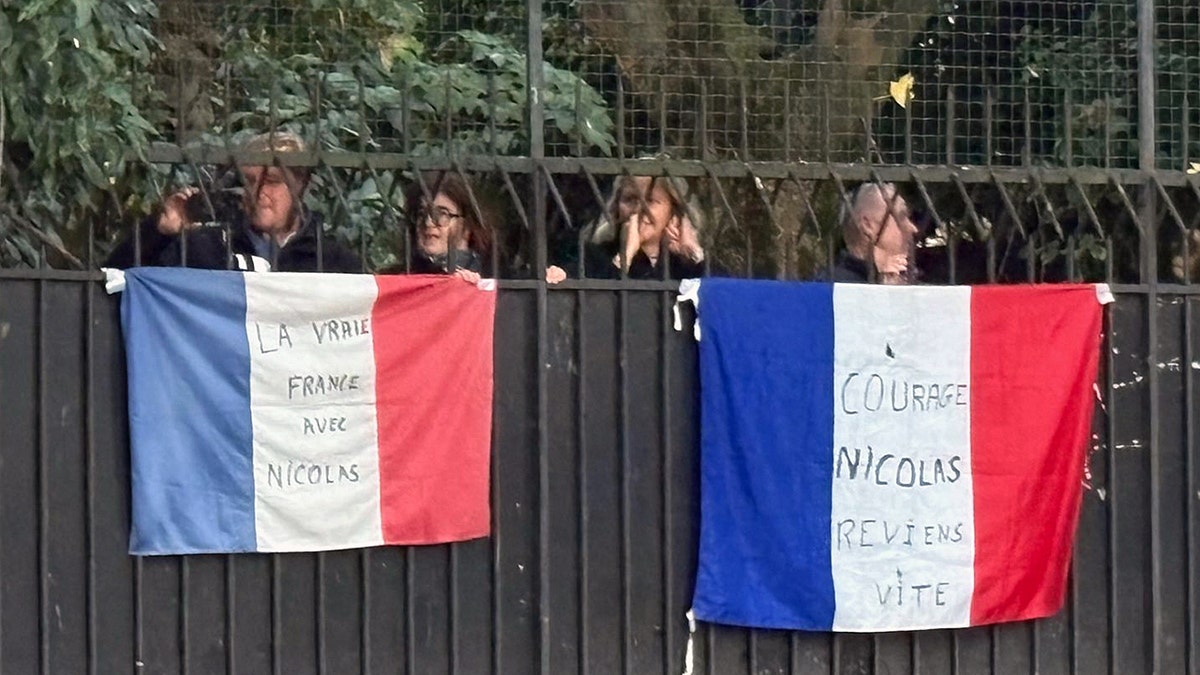
People stand behind French flags with inscription reading «Courage Nicolas, come back soon,» right, and «True France with Nicolas» outside former French President Nicolas Sarkozy’s home, on Tuesday, Oct. 21, 2025, in Paris. (AP Photo/Masha Macpherson)
An outpouring of support for the ex-president
Sarkozy’s journey from the presidential Elysée Palace to La Santé prison has captivated France.
After leaving their home, Sarkozy and his wife walked slowly to join family members, including his children and grandchildren, outside his home.
«I’m very proud to share his name, and very proud of how he’s reacting,» said his brother, Guillaume Sarkozy. «I’m truly convinced that he is innocent.»
Hundreds of supporters applauded and chanted «Nicolas, Nicolas» and sang the French anthem. Two French flags were hung on a nearby fence, with the words «Courage Nicolas, return soon» and «true France with Nicolas.»
Parisian resident Virginie Rochon, 44, came in support of Sarkozy, calling it «scandalous» to see «a former president being taken away while still presumed innocent.»
Another supporter, Véronique Maurey, 50, said: «it’s just not possible. And on top of that, calling it a ‘criminal conspiracy’ kind of makes all of us feel like criminals too, because we voted for him. It’s not right to say that.»
CLICK HERE TO GET THE FOX NEWS APP
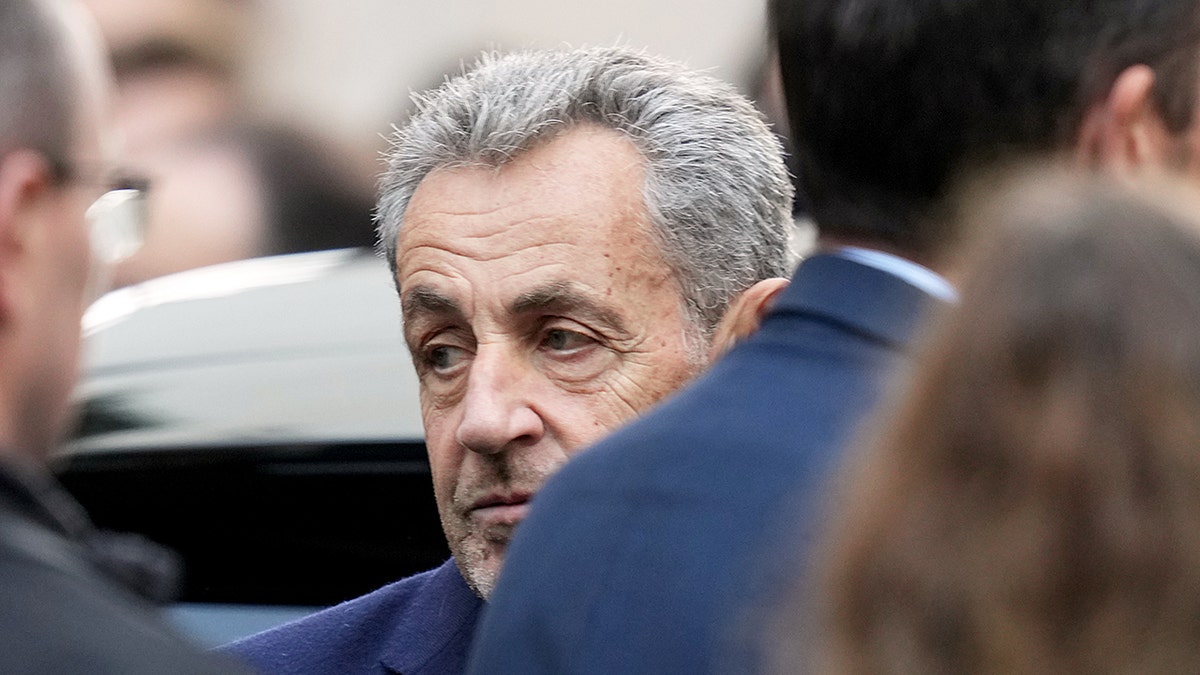
Former French President Nicolas Sarkozy reacts before entering a police car on Tuesday, Oct. 21, 2025, in Paris as he heads to prison to serve time for a criminal conspiracy to finance his 2007 election campaign with funds from Libya. (AP Photo/Thibault Camus)
Meeting with Macron
Embattled centrist President Emmanuel Macron hosted the conservative Sarkozy at the presidential palace last week, explaining it was «normal on a human level» to receive one of his predecessors in this context.
On Tuesday, Macron said he would not comment on a justice decision. «Nevertheless, it’s normal that the image of a president being imprisoned … may prompt comments,» he said.
«We must distinguish emotion, including the legitimate emotion of relatives and part of the country … and the proper functioning of justice,» Macron added.
Sarkozy has been retired from active politics for years but remains very influential, especially in conservative circles.
France’s top magistrate Rémy Heitz, Prosecutor-General at the Court of Cassation, warned Tuesday about a risk of «hindering (justice) serenity» and of «undermining the independence of judges,» including when the justice minister — a former conservative who joined Macron’s party — plans to visit Sarkozy in prison.
«The goal for everyone must be serenity, to allow justice to truly rule independently… free from any pressure,» Heitz said.
The Paris court ruled last month that Sarkozy would start to serve prison time without waiting for his appeal to be heard, due to «the seriousness of the disruption to public order caused by the offense.»
The court said Sarkozy, as a presidential candidate and interior minister, used his position «to prepare corruption at the highest level» from 2005 to 2007, to finance his presidential campaign with funds from Libya — then led by longtime ruler Moammar Gadhafi.
Under the ruling, Sarkozy was able to file a request for release to the appeals court only once behind bars. Judges have up to two months to process it.
france,associated press,world
INTERNACIONAL
Una hora de gimnasia diaria, lectura, escritura y tres visitas por semana: la nueva rutina de Nicolas Sarkozy en la cárcel
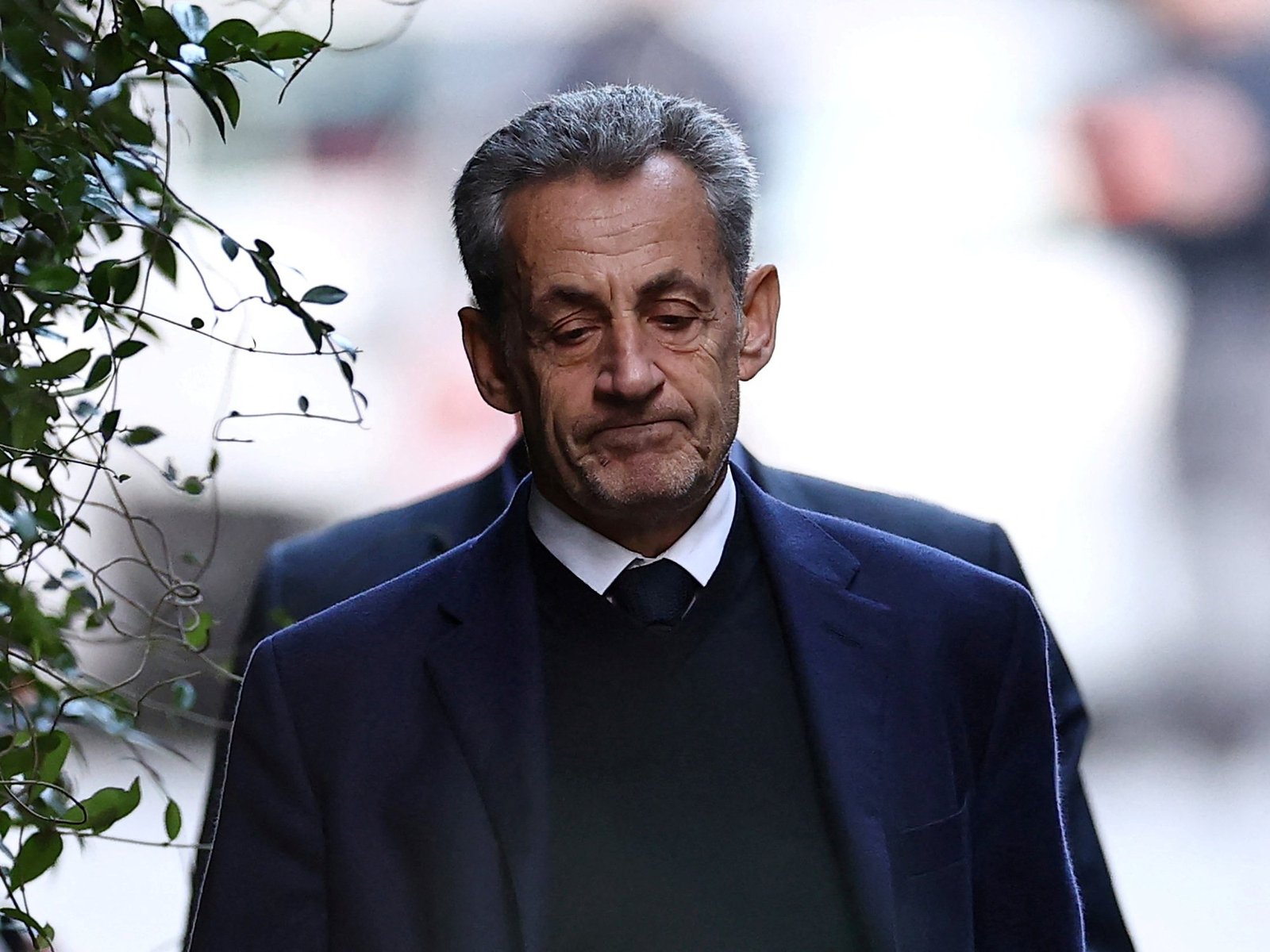
La Santé, una prisión muy antigua
Preso VIP
El último acto mediático antes de entrar a prisión
Carla Bruni, imputada
INTERNACIONAL
US military buildup in Caribbean sees bombers, Marines and warships converge near Venezuela
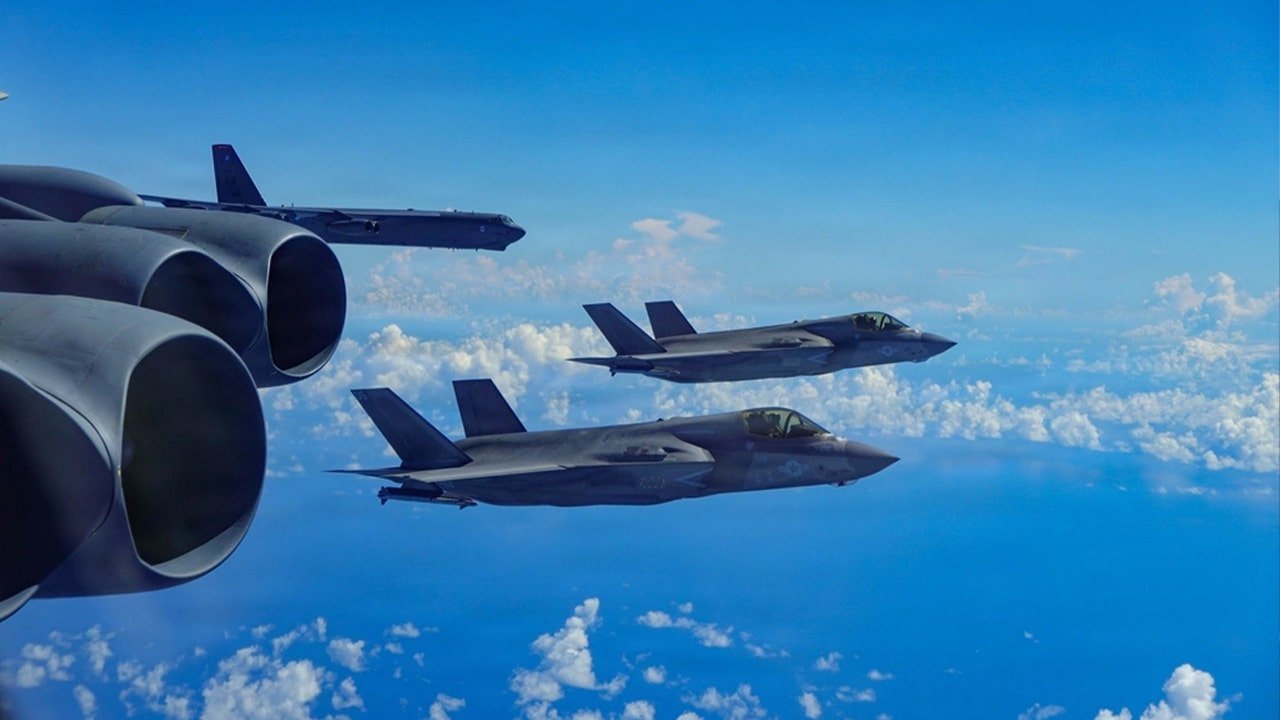
NEWYou can now listen to Fox News articles!
The United States has significantly increased its military presence across the Caribbean under U.S. Southern Command, deploying bombers, warships, and Marines as part of an expanded campaign targeting drug-trafficking and so-called «narco-terrorist» networks operating near Venezuela.
In addition to seven strikes on boats believed to be carrying narcotics, the Trump administration has built up thousands of troops in the region.
War Secretary Pete Hegseth this month announced the creation of a new counter-narcotics Joint Task Force operating near Southern Command, saying it was established «to crush the cartels, stop the poison, and keep America safe.» The task force will coordinate air, maritime, and special-operations missions across the region — marking the largest U.S. military effort in the Caribbean in decades.
U.S. Air Force B-52H Stratofortress bombers and Marine Corps F-35B Lightning II fighters recently conducted a bomber attack demonstration over the region — a show of force captured in Defense Department imagery. For four hours on Wednesday, B-52s from Barksdale Air Force Base in Louisiana patrolled near Venezuela’s coast in a display of military might aimed at Venezuelan dictator Nicolás Maduro.
TRUMP UNLEASHES US MILITARY POWER ON CARTELS. IS A WIDER WAR LOOMING?
President Donald Trump directed a deadly strike on a suspected drug-running boat, War Secretary Pete Hegseth said. (SecWar/X)
At least seven U.S. Naval warships and one nuclear submarine are believed to be patrolling the region.
The USS Iwo Jima Amphibious Ready Group is also operating in the Caribbean Sea. Ship spotters photographed the flagship USS Iwo Jima (LHD-7) off the coast of Ponce, Puerto Rico, on Friday. The group includes USS Fort Lauderdale (LPD-28), USS San Antonio (LPD-17) and the 22nd Marine Expeditionary Unit, based at Camp Lejeune and Marine Corps Air Station New River, N.C. The 22nd MEU comprises Marine Medium Tiltrotor Squadron 263 (Reinforced), Combat Logistics Battalion 26 and Battalion Landing Team 3/6.
Three U.S. Navy guided-missile destroyers — USS Jason Dunham (DDG-109), USS Gravely (DDG-107), and USS Stockdale (DDG-106) — are currently deployed in the Caribbean, joined by the guided-missile cruiser USS Lake Erie (CG-70) and the littoral combat ship USS Wichita (LCS-13), which has been operating near Cuba.
Open-source reporting indicates that a U.S. nuclear-powered attack submarine has been deployed near Venezuela, although the exact number of nuclear vessels and their precise locations have not been confirmed by the Pentagon.
WAR DEPARTMENT LAUNCHES NEW COUNTER-NARCOTICS TASK FORCE UNDER TRUMP DIRECTIVE TO CRUSH CARTELS
In Puerto Rico, the U.S. has deployed ten F-35 fighter jets and at least three MQ-9 Reaper drones, transforming the island into a key logistics and surveillance hub for operations in the region. Reuters imagery from Aguadilla, Puerto Rico, shows the drones staged for use.
Recent photos also show that Naval Station Roosevelt Roads, a major U.S. facility closed in 2004, has been reactivated. Satellite images and on-site photos reveal aircraft and personnel operating from the base, including at least one AC-130J Ghostrider gunship equipped with Hellfire missiles parked at José Aponte de la Torre Airport, which serves the installation.
Special-operations aviation has increased as well. In early October, MH-6 «Little Bird» light-attack helicopters — typically used by U.S. Army Special Operations Forces — and MH-60M Black Hawks were spotted training off the coast of Trinidad and Tobago, according to images first published by The Washington Post.
The Pentagon has not detailed how long the buildup will last, but a New York Times report estimates about 10,000 U.S. troops are currently operating in the theater — the largest American presence in the region in decades.
U.S. defense officials have linked the deployments to ongoing counter-narcotics and counter-terrorism missions tied to recent strikes on vessels accused of trafficking drugs from Venezuela. The moves come as tensions escalate following Colombia’s claim that one of the U.S. strikes killed a fisherman, not a trafficker — an accusation the White House has denied.
SECRETARY OF WAR HEGSETH LANDS IN PUERTO RICO AS US RAMPS UP CARIBBEAN CARTEL FIGHT WITH NAVAL FORCES
Analysts say the combination of heavy bombers, stealth fighters, Marines, and Navy surface combatants underscores a shift from law-enforcement interdiction to a broader show of force aimed at deterring state-linked trafficking networks.
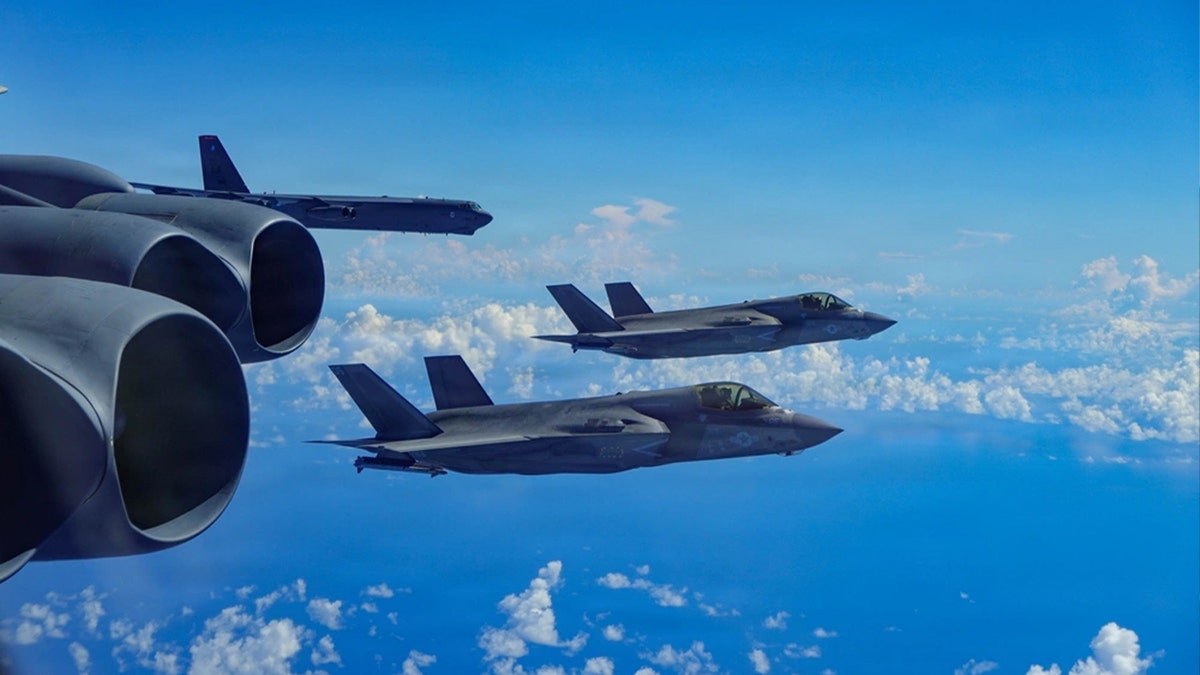
A U.S. Air Force B-52H Stratofortress bomber assigned to the 2nd Bomb Wing, integrates with a U.S. Marine Corps F-35B Lightning II aircraft assigned to the Marine Fighter Attack Squadron 225, in the U.S. Southern Command area. (U.S. Air Force)
«This is a posture we haven’t seen in the Caribbean since the early 2000s,» said one defense analyst familiar with U.S. operations in the region. «It’s clearly meant to send a message — not just to traffickers, but to governments accused of enabling them.»
Experts generally agree the U.S. buildup does not suggest preparations for all-out war.
Mark Cancian, a senior defense adviser at the Center for Strategic and International Studies, told Fox News Digital that such a campaign would require between 50,000 and 100,000 U.S. troops — far more than the roughly 10,000 currently in theater.
«What I think they’ve put in place is the capability to launch strikes at either the cartels or the Maduro regime,» Cancian said. «If I had to bet, it’s probably against the cartels — but I wouldn’t rule out something against the regime.»
That limited but flexible posture reflects what some experts describe as a modern form of coercive diplomacy.
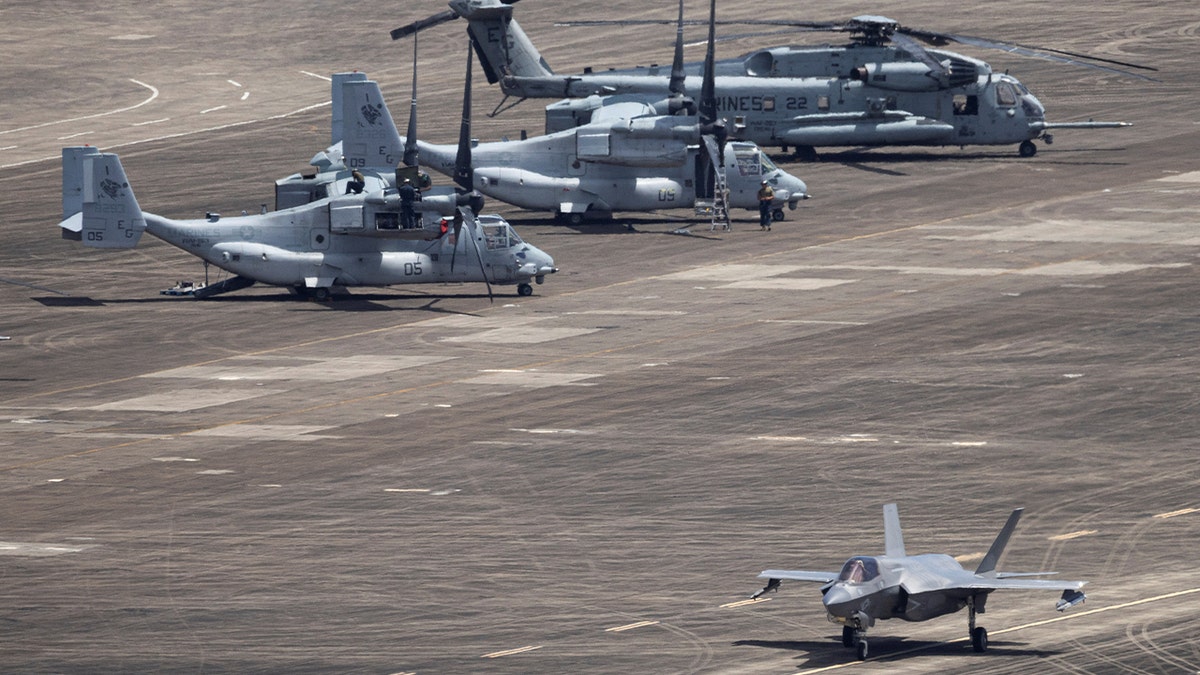
A U.S. Marine Corps F-35 fighter jet taxies on the tarmac past U.S. Marine Corps Ospreys and helicopters are now parked at the former Roosevelt Roads military base in Ceiba, Puerto Rico, which had been closed for decades. (Ricardo Arduengo/Reuters)
«It sort of looks like we’re in the throes of a 21st-century version of gunboat diplomacy,» said Brandan Buck, a foreign policy analyst at the Cato Institute. «The Trump administration is doing what it can to force some sort of transition [of] power — out of Maduro’s hands and into someone else’s — without a classic invasion.»
CLICK HERE TO DOWNLOAD THE FOX NEWS APP
Ryan Berg, director of the Americas Program at the Center for Strategic and International Studies, said the current deployment gives Washington strike options without committing to a major ground war.
«The force posture currently in the southern Caribbean is consonant with the potential for precision strikes using Tomahawk missiles or other weapons, but without risking the lives of U.S. service personnel,» Berg said.
latin america,pentagon,defense,military,caribbean

 POLITICA3 días ago
POLITICA3 días agoUn juez federal rechazó el habeas corpus presentado por Lázaro Báez y ordenó trasladarlo a la cárcel de Ezeiza

 CHIMENTOS2 días ago
CHIMENTOS2 días agoLa fuerte actitud de Manu Urcera con Indiana Cubero que reveló la verdad de la interna familiar: “El saludo del piloto a la hija de Nicole Neumann por su cumpleaños”

 CHIMENTOS2 días ago
CHIMENTOS2 días agoLa cruda confesión del Turco Naim a 1 año de la separación de Emilia Attias: «Me di cuenta que hay que aprender a estar solo»

